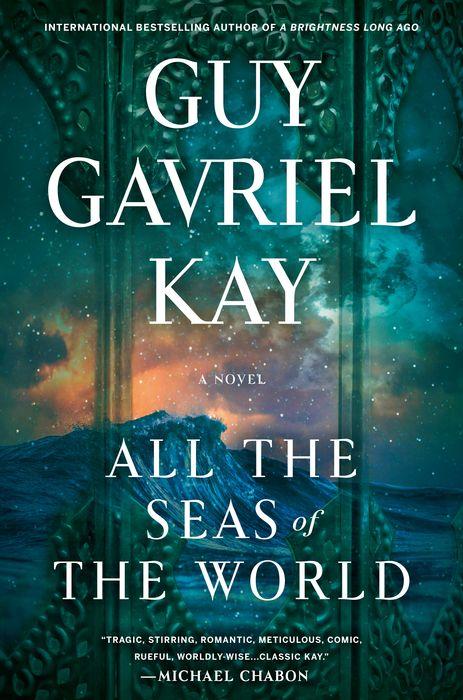My first foray into Guy Gavriel Kay’s writing has been one of the most artful instances of unintentional edging I’ve had in a long time. In theory, All the Seas of the World is an easy sell, with real-world historical inspirations, and an elaborate pirate setting (I do love Black Sails) done in what the publisher describes as his signature “quarter turn to the fantastic” style. Kay is best known for these types of historical fantasies—dramatic fiction that draws from defining eras of past centuries, encompassing everything from a reimagined Tang Dynasty to a range of alternate medieval Europes. All the Seas of the World follows the same formula against a backdrop of religious war and seafaring corsair culture with Middle Eastern and Mediterranean flavors.
Actually getting through Seas was, at turns, gripping and frustrating. For historical fantasies of this scope—the kind of far-reaching stories that flit across oceans and kingdoms and mention ten names in one breath—the first few chapters are often a rude baptism of worldbuilding, jargon, and geography that really takes time to sink in. Generally speaking, getting accustomed to this particular kind of historical genre is an acquired taste, as well as an acquired skill in learning to move along without getting overwhelmed by the frequency and volume of details and stylistic shifts.
At the heart of Kay’s story are Rafel and Nadia—street-smart “merchants” for hire who take on an elaborate assassination job that will make waves across the world. Nadia is particularly interesting as an ex-slave on the cusp of rediscovering her autonomy, while working within (and around) social systems and structures drawn from historical patriarchy. As things go sensationally wrong on the job, the novel explores the ripple effect of their individual actions and choices that lead to both new and forgotten discoveries. This is a world of hierarchies, rituals, traditions and a fragile coexistence of three cultures: Jaddites, Asharites, and marginalized Kindath. Naturally, all of this holy chauvinism is a constant cause of conflict, especially between the notorious Asharite conqueror Gurçu, and the sun-worshipping Jaddite High Patriarch.
Overall, Kay makes a refreshing departure from a lot of fusty old “hero’s journey” conventions in favor of something closer to Plutarch’s Lives than a traditional adventure—there’s a lot of expositional detail about historical context and conquerors’ records that Kay weaves within a slow, dance-like approach to plot progression. There’s a vast constellation of supporting characters, personages, and one-off bit players who may only show up for one or two chapters—a bold approach that works well when Kay gives them an appropriately spicy exit or simply observes that they were never seen by Rafel or Nadia again. It serves the idea of a vast world well, mimicking the full range of banal daily interactions to profound, life-changing meetings. But it’s one that constantly threatened to lose my interest, if not for Kay’s talent for crafting genuinely evocative scenes that lend themselves well to the visual imagination.
Buy the Book


All the Seas of the World
Serissa was a particularly interesting location seemingly modeled after the canal-like structure of Venice, but here’s also where Kay just dives into throwing first-person paragraphs into the mix—not from Rafel or Nadia’s perspective, but a relatively new character, Cerra. The key to pulling off these decisions—to reeling in a reader who still isn’t committed to the book’s sprawling realm and lore dumps—is a delicate balance between perseverance and payoff, and here your mileage may vary.
The narrative feels most anchored when it’s being told by a core character (either Rafel or Nadia), or at the very least, someone who isn’t in histrionics over an unexpected incident; Kay does a wonderful job at inhabiting frantic, tense characters in especially neurotic, high-strung moments, but when he’s flitting in and out of voices multiple times per chapter, it can be a lot.
Kay also leans heavily on expository repetition, which has a double-edged effect: on one hand, there’s so much going on all the time that it’s not a bad idea to constantly remind the reader that Kindath must wear identifying blue-and-white colors, or that women typically weren’t merchants. On the other hand, if you’ve already made it this far, they’re details that a reader should have organically internalized. It’s tiresome to re-encounter echoed explanations for Nadia’s unusual behavior for a woman halfway through the book—after all, we’ve been with her since the beginning. If you’re basing the story on real history and already devoted a hundred pages to describing the cultural, social, and political factors that drive human behavior in the story, these constant reminders can come off as unnecessary spoon-feeding.
Overall, Kay’s ambition for this world is undercut by the uneven texture of the prose. The depth and breadth of his historical research—the heart and soul of his work—is clear, and I particularly enjoyed the details about mercantile systems and age-old maritime insurance. I became genuinely invested in Nadia’s story and her journey to find her relationship to the subtle magical “half-world” that calls to her. But for every few pages of expressive scenes, the next few pages would completely dislodge my sense of immersion. It was, in short, a real challenge to get through the book, even acknowledging (and in many instances, admiring) Kay’s gift for researching and crafting elaborate historical worlds, down to their economic policies and systems. All the Seas of the World is ultimately an exercise in patience, pushing the boundaries of vivid but erratically-styled storytelling.
All the Seas of the World is published by Berkley and Viking Canada
Read an excerpt here
Alexis Ong is a freelance culture journalist with weak ankles who mainly writes about games, tech, and pop culture. Her work has appeared in The Verge, Polygon, Kotaku, Rock Paper Shotgun, VICE, Dazed Digital, and more; soft spots include science fiction, internet archaeology, comics, boxing, and old games. You can find her at her website or on Twitter.










